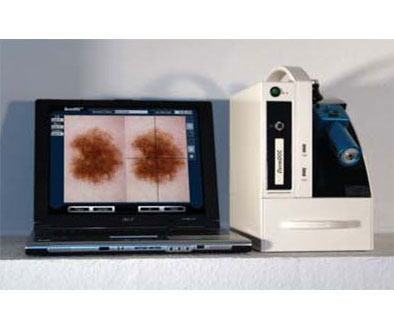What is Melonama
Melanoma is a malignant tumor of melanocytes. Such cells are found predominantly in skin, but are also found in the bowel and the eye (see uveal melanoma). Melanoma is one of the less common types of skin cancer, but causes the majority (75%) of skin cancer related deaths. Melanocytes are normally present in skin, being responsible for the production of the dark pigment melanin. Despite many years of intensive laboratory and clinical research, early surgical resection of thin tumors still gives the greatest chance of cure. Around 60,000 new cases of invasive melanoma are diagnosed in the United States each year, more frequently in males and in Caucasians. It is more common in Caucasian populations living in sunny climates than in other groups, or in those who use tanning salons. According to a WHO report about 48,000 melanoma related deaths occur worldwide per year. The treatment includes surgical removal of the tumor, adjuvant treatment, chemo- and immunotherapy, or radiation therapy.
Around 60,000 new cases of invasive melanoma are diagnosed in the United States each year, more frequently in males and in Caucasians. It is more common in Caucasian populations living in sunny climates than in other groups, or in those who use tanning salons. According to a WHO report about 48,000 melanoma related deaths occur worldwide per year. The treatment includes surgical removal of the tumor, adjuvant treatment, chemo- and immunotherapy, or radiation therapy.

Basal Cell Carcinoma
Basal cell carcinoma is the most common type of skin cancer. It rarely metastasizes or kills, but it is still considered malignant because it can cause significant destruction and disfigurement by invading surrounding tissues. Statistically, approximately 3 out of 10 Caucasians develop a basal cell cancer within their lifetime. In 80 percent of all cases, basal cell cancers are found on the head and neck. There appears to be an increase in the incidence of basal cell cancer of the trunk (torso) in recent years.

Squamous Cell Carcinoma
Squamous cell carcinoma (SCC) is a form of cancer of the carcinoma type that may occur in many different organs, including the skin, lips, mouth, esophagus, urinary bladder, prostate, lungs, vagina, and cervix. It is a malignant tumor of squamous epithelium (epithelium that shows squamous cell differentiation). Despite the common name, these are unique cancers with large differences in manifestation and prognosis.

